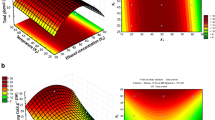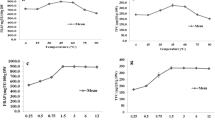Abstract
Extraction of antioxidants from aloe gel powder with water–ethanol solvents was studied using response surface methodology. The independent variables were solvent composition, temperature, extraction time, and the liquid-to-solid (L/S) ratio. The concentrations of potentially antioxidant compounds (aloin A and B, aloesin, total phenolics, and total carbohydrates) and a few indicators of antioxidant capacity (DPPH, FRAP, CUPRAC) served as the response functions. It was found that aloe gel contains both phenolic and non-phenolic antioxidants, and it was supposed that the phenolic fraction consists almost exclusively of chromones and anthrones. Different approaches to the optimization of extraction procedures are discussed, and here, the maximum recovery yield of antioxidants is achieved with 34 % ethanol at 60 °С and a L/S ratio of 46 in 1 h. The use of 90 % ethanol results in a higher antioxidant capacity of the product, but also results in a much lower extraction yield, decreasing the overall productivity of the process.



Similar content being viewed by others
References
Ahlawat KS, Khatkar BS (2011) Processing, food application and safety of Aloe vera products: a review. J Food Sci Technol 48(5):525–533
Apak R, Güçlü K, Özyürek M, Karademir SE (2004) Novel total antioxidant capacity index for dietary polyphenols and vitamins C and E, using their cupric ion reducing capability in the presence of neocuproine: CUPRAC method. J Agric Food Chem 5:7970–7981
Benzie IFF, Strain JJ (1996) The ferric reducing ability of plasma (FRAP) as a measure of “antioxidant power”: the FRAP assay. Anal Biochem 239:70–76
Botes L, van der Westhuizen FH, Loots DT (2008) Phytochemical contents and antioxidant capacities of two Aloe greatheadii var. davyana extracts. Molecules 13:2169–2180
Brand-Williams W, Cuvelier ME, Berset C (1995) Use of a free radical method to evaluate antioxidant activity. Lebensm Wiss Technol 28:25–30
Choung SY (2006) In: Park YI, Lee SK (eds) New perspectives on Aloe. New York, Springer
Deming SM, Morgan SL (1993) Experimental design: a chemometric approach, 2nd edn. Elsevier, Amsterdam
Escribano-Bailon MT, Santos-Buelga C (2003) In: Santos-Buelga C, Williamson G (ed) Methods in polyphenol analysis. The Royal Society of Chemistry, Cambridge
Eshun K, He Q (2004) Aloe vera: a valuable ingredient for the food, pharmaceutical and cosmetic industries—a review. Crit Rev Food Sci Nutr 44:91–96
Habeeb F, Shakir E, Bradbury F, Cameron P, Taravati MR, Drummond AJ, Gray AI, Ferro VA (2007) Screening methods used to determine the anti-microbial properties of Aloe vera inner gel. Methods 42:315–320
He L, Song X-L, Lu W (2006) Studies on optimization of extraction process and superoxide scavenging capability of polysaccharides from Aloe arborescens Mill. Amino Acids Biotic Res 28(2):35–37
He ZP, Wu ZM, Han Y (2012) Reflux extraction of aloetic anthraquinones. Adv Mater Res 441:522–525
Hu Y, Xu J, Hu Q (2003) Evaluation of antioxidant potential of Aloe vera (Aloe barbadensis Miller) extracts. J Agric Food Chem 51:7788–7791
Hu Q, Hu Q, Xu J (2005) Free radical-scavenging activity of Aloe vera (Aloe barbadensis Miller) extracts by supercritical carbon dioxide extraction. Food Chem 91:85–90
International Aloe Science Council (2004) http://www.iasc.org
Lee KY, Weintraub ST, Yu BP (2000) Isolation and identification of a phenolic antioxidant from Aloe barbadensis. Free Radic Biol Med 28:261–265
Zhao L-C, Liang J, Li W, Cheng K-M, Xia X, Deng X, Yang G-L (2011) The use of response surface methodology to optimize the ultrasound-assisted extraction of five anthraquinones from Rheum palmatum L. Molecules 16:5928–5937
Liu C-h, Wang C-h, Xu Z-l, Wang Y (2007) Isolation, chemical characterization and antioxidant activities of two polysaccharides from the gel and the skin of Aloe barbadensis Miller irrigated with sea water. Process Biochem 42:961–970
Li W, Wang Z, Sun Y-s, Chen L, Han L-k, Zheng Y-n (2010) Application of response surface methodology to optimise ultrasonic-assisted extraction of four chromones in Radix saposhnikoviae. Phytochem Anal 22:313–321
Loots DT, van ber Westhuizen FH, Botes L (2007) Aloe ferox leaf gel phytochemical content, antioxidant capacity, and possible health benefits. J Agric Food Chem 55:6891–6896
Miller JN, Miller JC (2005) Statistics and chemometrics for analytical chemistry, 5th edn. Pearson Education Ltd., Harlow
Minkin B (2011) Core concepts in data analysis: summarization, correlation and visualization. Springer, London
Park YI, Hyung JT (2006) In: Park YI, Lee SK (eds) New perspectives on Aloe. Springer, New York
Prasad KN, Hassan FA, Yang B, Kong KW, Ramanan RN, Azlan A, Ismail A (2011) Response surface optimisation for the extraction of phenolic compounds and antioxidant capacities of underutilised Mangifera pajang Kosterm peels. Food Chem 128:1121–1127
Prior RL, Wu X, Schaich K (2005) Standardized methods for the determination of antioxidant capacity and phenolics in foods and dietary supplements. J Agric Food Chem 53:4290–4302
Rajasekaran S, Sivagnanam K, Subramanian S (2005) Modulatory effects of Aloe vera leaf gel extract on oxidative stress in rats treated with streptozotocin. J Pharm Pharmacol 57:241–246
Rodríguez ER, Martín JD, Romero CD (2010) Aloe vera as a functional ingredient in foods. Crit Rev Food Sci Nutr 50(4):305–326
Shahidi F, Wanasundara PK, Janitha PD (1992) Phenolic antioxidants. Crit Rev Food Sci Nutr 32:67–103
Sharma OP, Bhat TK (2009) DPPH antioxidant assay revisited. Food Chem 113:1202–1205
Sultana B, Anwar F, Ashraf M (2009) Effect of extraction solvent/technique on the antioxidant activity of selected medicinal plant extracts. Molecules 14:2167–2180
Tang YM, Jiao S, Leng L, Tang PC, Liu J, Feng H (2011) Optimization of process parameters of extraction antioxidants from Aloe using response surface methodology. Chin J Bioproc Eng 1:24–28
Waller TA, Pelley RP, Strickland FM (2004) In: Reynolds T (ed) Aloes: the genus Aloe. CRC, Boca Raton
Wang GH, SU P, Zhang F, Hou XY, Yang Y, Guo ZK (2011) Comparison of microwave-assisted extraction of aloe-emodin in aloe with Soxhlet extraction and ultrasound-assisted extraction. Sci China 54:231–236
Xiao X, Song W, Wang J, Li G (2012) Microwave-assisted extraction performed in low temperature and in vacuo for the extraction of labile compounds in food samples. Anal Chim Acta 712:85–93
Yagi A, Kabash A, Okamura N, Haraguchi H, Moustafa SM, Khalifa TI (2002) Antioxidant, free radical scavenging and anti-inflammatory effects of aloesin derivatives in Aloe vera. Planta Med 68(11):957–960
Yagi A, Kabash A, Mizuno K, Moustafa SM, Khalifa TI, Tsuji H (2003) Radical scavenging glycoprotein inhibiting cyclooxygenase-2 and thromboxane a2 synthase from Aloe vera gel. Planta Med 69(3):269–271
Acknowledgments
This paper resulted from the Konkuk University research support program.
Compliance With Ethics Requirements
The authors declare that the design, performance, and reporting of research funded under the Bio-industry Technology Development Program (111093-3) grants is free from bias resulting from investigator financial conflicts of interest. No financial relationship with other institutions or private industry has influenced the results of this study.
Conflict of Interest
Seol Kim declares that he has no conflict of interest. Leonid Asnin declares that he has no conflict of interest. Awraris D. Assefa declares that he has no conflict of interest. Eun Young Ko declares that he has no conflict of interest. Kavita Sharma declares that he has no conflict of interest. Se Won Park declares that he has no conflict of interest. This article does not contain any studies with human or animal subjects.
Author information
Authors and Affiliations
Corresponding author
Electronic supplementary material
Below is the link to the electronic supplementary material.
ESM 1
(DOC 462 kb)
Rights and permissions
About this article
Cite this article
Kim, S., Asnin, L., Assefa, A.D. et al. Extraction of Antioxidants from Aloe vera Leaf Gel: a Response Surface Methodology Study. Food Anal. Methods 7, 1804–1815 (2014). https://doi.org/10.1007/s12161-014-9822-x
Received:
Accepted:
Published:
Issue Date:
DOI: https://doi.org/10.1007/s12161-014-9822-x




